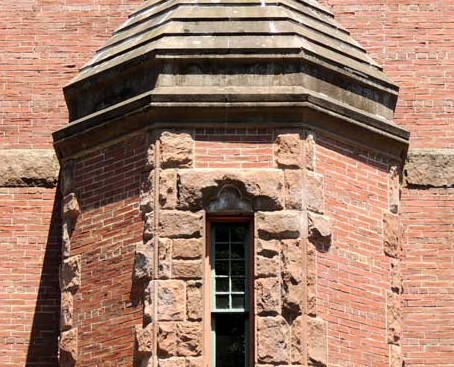
Oakes Ames Memorial Hall is one of the grandest and most magnificent buildings in America – and one of the most popular and preferred special event spaces in Metropolitan Boston.
The building is designed by Henry Hobson Richardson (often called H.H. Richardson), and the grounds that the hall sits on are designed by Frederick Law Olmsted (sometimes referred to as F.L.O.).
H.H. Richardson, along with Louis Sullivan and Frank Lloyd Wright, constitute the “Trinity of American Architects.” Frederick Law Olmsted is widely known as the “Father of American Landscape Architecture.”
That is a lot of design talent manifest in one property.
In this space we occasionally highlight and discuss specifics and particulars of the design and architectural character of Messrs. Richardson and Olmsted.
In the most recent post, for example – which can be accessed by here – we featured a featured a design element that H.H. Richardson favored and frequently employed: polychromy.
Today we feature another design characteristic that is a “go-to” and a staple of an H.H. Richardson building – and is evident throughout the exterior of Oakes Ames Memorial Hall.
We are talking … “rustication.”
And what is rustication?
Here is a helpful description of rustication found at infoplease:
in building construction, method of creating textures upon masonry wall surfaces, chiefly upon those of stone, by projecting the blocks beyond the surface of the mortar joints. Each joint thus lies in a channel or in a V-shaped groove, between adjoining stones, and a separating shadow line is produced. The degree of projection, whether slight or bold, permits varying effects.”
Rustication in architecture has a long history.
From an entry on rustication found at the Encyclopedia Britannica website:
Rusticated masonry is found as early as the platform of the tomb of Cyrus II (the Great) at Pasargadae in Persia (560 bc) and was commonly used for Greek and Hellenistic retaining walls and terraces.”
Ancient Roman architecture includes rustication. Renaissance architects developed their own forms of rustication, as did those in succeeding periods of architecture and design.
Rustication would become identified and accepted as a classical form of decoration.
Indeed, many of the classical designs of H.H. Richardson – including those incorporated into his own school of architecture, Richardsonian Romanesque – are rich in rustication representation.
Rustication, applied by Henry Hobson Richardson, is one more technique, one more style element, that makes Oakes Ames Memorial Hall so beautiful and extraordinary.